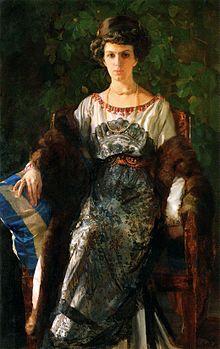Nadezhda Petrovna Lamanova

Nadezhda Petrovna Lamanova ( Russian Надежда Петровна Ламанова ; born December 14 . Jul / 26. December 1861 greg. In Schutilowo ( Rajon Pervomaysk ); † 15. October 1941 in Moscow ) was a Russian fashion designer .
Life
Lamanowa was the eldest of the 5 daughters of Colonel Pyotr Michailowitsch Lamanow from an impoverished aristocratic family and the daughter of Major General Nadezhda Alexandrovna. She attended the seven-year Marian School for girls of the first order (from 1883 Marian High School for girls) in Nizhny Novgorod . She then completed the 8th grade voluntarily, after which she was allowed to teach geography at peasant schools.
After finishing school, Lamanova left her parents' home and went to Moscow, where, thanks to the support of Princess Alexandra Nikolajewna Strekalowa and her daughter Natalia Stepanovna Lieven, she was initially able to attend the O. A. Suvorova School for Cutting and Sewing. After two years of training, she started working in the Woitkewitsch workshop in 1879 and soon became a leading tailor .
In 1885, Lamanova opened her own shop in Moscow and a free school for applied arts . After just a few years, she was very well known and loved by artists , actors and directors . She traveled to Paris to learn about fashion collections by famous masters and to read books on history , painting and ethnography . She studied the history of national costume in view of the popularity of folk motifs in the highest circles. In 1898 she was appointed purveyor to the court of Grand Duchess Jelisaveta Fyodorovna and in 1904 purveyor to the court of Empress Alexandra Fyodorovna . In the late 1890s she married the young lawyer and amateur actor Andrei Pavlovich Kajutow . The marriage remained childless. They regularly donated to a city children's home.


In 1901 Lamanova was invited by Konstantin Sergejewitsch Stanislavski to work in the Moscow Art Theater , where she worked until her death. In 1908 she set up her studio in her own house built by the architect Nikita Gerasimowitsch Lasarew on Moscow's Tverskoy Bulwar 10. In 1911 she created a dress for Evfimija Pavlovna Nossowa , which can be seen in her portrait of Konstantin Andrejewitsch Somow in the Tretyakov Gallery .
After the October Revolution , the former purveyor to the court, Lamanova, was arrested in 1919 and only released after two and a half months thanks to Maxim Gorki's intervention . She now developed simple models for the general public. At the same time she was engaged in clothing modeled on Russian folk costumes . From 1921 she worked in Moscow's Vakhtangov Theater . In 1922 she became a member of the Academy of Fine Arts. In 1925 she and Vera Ignatievna Muchina published an album on art in everyday life. In the same year, her models were exhibited at the Exposition Internationale des Arts Décoratifs et industriels modern and awarded a Grand Prix. Her dresses in Russian style caused a sensation and had a style-forming effect. In 1926 she was commissioned to design models based on motifs of the Nordic peoples for export. She designed a fur collection for an exhibition in Leipzig , and in 1929 took part in an exhibition in New York . In 1928 her right to vote was withdrawn because she employed two artists . In 1930 she became the manager of a workshop for the mech combination .
Lamanowa created costumes for Eisenstein's Alexander Newski and other Eisenstein films as well as for films by Grigori Wassiljewitsch Alexandrow and Jakow Alexandrowitsch Protasanow .
Lamanova's younger sister Marija Petrovna had become a hat maker and helped her sister after the October Revolution. The third oldest sister Ekaterina Petrovna married the actor of the Imperial Russian Dramatic Theater Alexander Semjonowitsch Schwarzschild in St. Petersburg and ran a tailoring shop.
Lamanova died after the beginning of the German-Soviet War during the evacuation of Moscow. Because of the constant bombardment, a normal funeral was not possible, so she was cremated. Her grave is in the Wagankowoer cemetery .
Since 1994, the Moscow fashion house Slawa Saizews and another fashion house have held the Nadezhda Lamanova competition for fashion designers. In 2016 the first scientific and practical conference of the Saizew fashion house on Russian fashion took place, which was dedicated to the life and work of Lamanova.
Individual evidence
- ↑ a b Т. Стриженова: Судьба Надежды Ламановой (accessed May 9, 2018).
- ↑ a b c Надежда Ламанова: от императорского платья до народного костюма (accessed May 9, 2018).
- ↑ Эта удивительная Ламанова (accessed May 9, 2018).
- ↑ a b c d e Большая российская энциклопедия: ЛА́МАНОВА (accessed on May 9, 2018).
- ↑ Ателье Ламановой (accessed May 9, 2018).
- ↑ Т.Стриженова: Из истории советского костюма . Советский художник, Moscow 1972, p. 32 .
| personal data | |
|---|---|
| SURNAME | Lamanova, Nadezhda Petrovna |
| ALTERNATIVE NAMES | Ламанова, Надежда Петровна (Russian) |
| BRIEF DESCRIPTION | Russian fashion designer |
| DATE OF BIRTH | December 26, 1861 |
| PLACE OF BIRTH | Shutilovo ( Pervomaisk Raion ) |
| DATE OF DEATH | October 15, 1941 |
| Place of death | Moscow |
